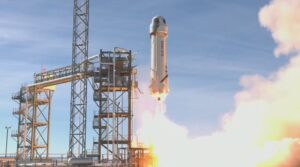That launch is scheduled for a window that opens at 9 a.m. Eastern April 14. Launch opportunities run through April 17, according to temporary flight restrictions published by the Federal Aviation Administration.
During prelaunch preparations, Blue Origin personnel will board the vehicle, strap into seats and test communications, much as astronauts flying on the vehicle would do. Ground personnel will close the hatch briefly, simulating closeouts prior to launch, before opening the hatch again and allowing the personnel to exit the capsule.
After New Shepard completes its uncrewed suborbital flight, personnel will board the capsule to simulate opening the hatch and exiting the capsule after a flight.
The company said this flight, designated NS-15, will be “a verification step for the vehicle and operations prior to flying astronauts.” Besides the preflight and postflight rehearsals, the vehicle will carry the company’s “Mannequin Skywalker” anthropomorphic test device and more than 25,000 student postcards.
This vehicle first flew Jan. 14 on a suborbital test flight to 107 kilometers. At the time, the company said this vehicle would be the one that will later carry the company’s first astronauts. After the successful test flight, company officials said they were “getting really close to flying humans,” but were not more specific on a schedule for flying people.
Blue Origin expected to already be flying people by now. In a February 2019 interview, Jeff Bezos, the billionaire founder of Blue Origin, said he expected crewed flights to begin by the end of that year. By October 2019, though, the company said they would not meet that schedule because they needed more time to ensure the vehicle would be safe enough for people.
Blue Origin conducted just one New Shepard test flight in 2020, in October. After that flight the company said they expected to need “just a couple more flights” before they would start flying people.



